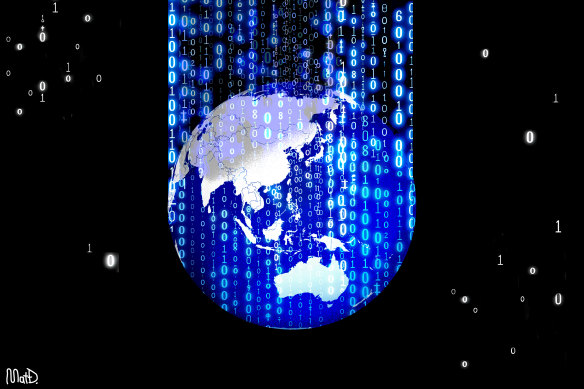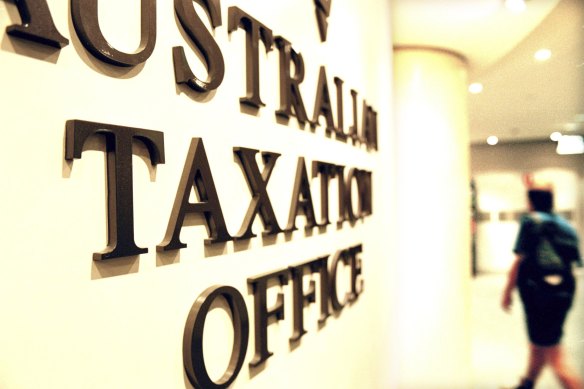This was published 1 year ago
Opinion
How the digital world is getting better at measuring us up
Ross Gittins
Economics EditorThese days we hear incessantly about “data”. The media is full of reports of new data about this or that, and there’s a new and growing occupation of data analysts and even data scientists. So, what is data, where does it come from, what are people doing with it, and why should I care?
Google “data” and you find it’s “facts and statistics collected together for reference or analysis”. The advent of computers has allowed businesses and governments to record, calculate, play with and store huge amounts of data.

Credit: Matt Davidson
Businesses have data about what goods and services they’re making, buying and selling, importing or exporting, and paying their workers, going back for 30 or 40 years.
Our banks have data about what we earn and what we spend it on, especially when we use a credit or debit card – or our phone – to pay for something.
Much of this data is required to be supplied to government agencies. If you ever go onto the Australia Taxation Office’s website to do your annual tax return, it will offer to “pre-fill” your return with stuff it already knows about your income from wages, bank interest and dividends.
Try it sometime. You’ll be amazed by how much the taxman knows and how accurate his data are.
Another dimension of the “information revolution” is how advances in international telecommunications – including via satellites – have allowed us to be in touch with people and institutions around the world in real-time via email and the web – news, entertainment, social media, whatever.
Last month, the Australian Statistician – aka the boss of the Australian Bureau of Statistics – Dr David Gruen, gave a speech outlining some of the ways these huge banks of “big data” about the economic activities of the nation’s businesses, workers, consumers and governments can be used to improve the way we measure the economy in all its aspects: employment, inflation, gross domestic product and the rest.
We’re getting more information and more accurate information, and we’re getting it much sooner than we used to. But we’re still in the early days of exploiting this opportunity to be better informed about what’s happening in the economy and to have better information to guide the government’s decisions about its policies to improve the economy’s performance.
Gruen starts by describing the Tax Office’s “single-touch” payroll system, software that automatically receives information about employees’ payments every time an employer runs its payroll program.
Not all employers have the software, but those who do account for more than 10 million of our 14 million employees.

The Australian Taxation Office is a major user of “big data”.Credit: Louie Douvis
Gruen says the arrival of the pandemic in early 2020 made access to this “rich vein of near real-time information” an urgent priority. The taxman pulled out the stops, and the stats bureau began receiving these data in early April 2020.
With a virus spreading through the land and governments ordering lockdowns and border closures, they couldn’t afford to wait a month or more to find out what was happening in the economy. Thus, the whole project of using big data to help measure the economy received an enormous kick along – here and in all the other rich economies.
So, in addition to the longstanding monthly sample survey of the labour force, we now have a new publication: Weekly Payroll Jobs and Wages Australia. These data allowed the “econocrats”—and the rest of us—to chart the dramatic collapse in jobs across the economy over the three weeks from mid-March 2020.
They show employment in the accommodation and food services industry falling by more than a quarter in just three weeks. Employment in the arts and recreation services industry fell by almost 20 per cent. By contrast, falls in utilities and education and training were minor.
The monthly labour force survey has a sample size of about 50,000 people, compared with the payroll program’s 10 million-plus people, meaning it provides information on far more dimensions of the workforce than the old way does.
So, the bureau’s access to payroll data taught it new ways of doing things. And the pandemic increased econocrats’ appetite for more info about the economy that was available in real-time.
With household consumption – consumer spending – accounting for about half of gross domestic product, improving the timeliness and detail of the data was a great idea.
So, in February 2022, the bureau released the first monthly household spending indicator using (note this) aggregated and de-identified data on credit and debit card transactions supplied by the major banks. This indicator provides two-thirds coverage of household consumption, compared with the less than one-third coverage provided by the usual survey of retail trade.
The bureau has also begun publishing a monthly consumer price index in addition to the usual quarterly index. This is possible because big data – in the form of data from scanners at checkout counters and data scraped from the websites of supermarket chains – is much cheaper to gather than the old way.
The bureau has also started integrating different but related sets of big data from several sources, so analysts can study the behaviour of individual consumers or businesses. It has developed two large integrated data assets.
The one for individuals links families and households with data sets on income and taxation, social support, education, health, migrants and disability.
The one for businesses links them with a host of surveys of aspects of business activity, income and taxation, overseas trade, intellectual property and insolvency.
The purpose is to allow analysts from government departments, universities or think tanks to shed light on policy problems from multiple dimensions.
For instance, one study showed that people over 65 who’d had their third COVID vaccination within the previous three months were 93 per cent less likely to die from the virus than an unvaccinated person. But that’s just the tiniest example of what we’ll be able to find out.
Ross Gittins is the economics editor.
The Business Briefing newsletter delivers major stories, exclusive coverage and expert opinion. Sign up to get it every weekday morning.